Edie Melson's Blog, page 134
February 28, 2022
The Main Characteristics About the Main Characters We Write
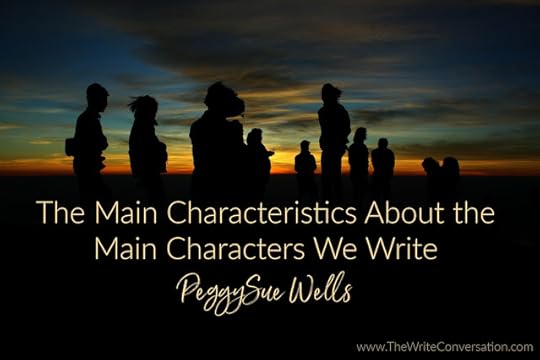
by PeggySue Wells @PeggySueWells
Stories are plot driven or character driven, and even better when you create a story that is plot and character driven.
Plot is what people do and why they do it. Character is the internal organization and structure of a person that motivates how the character responds to external pressures. In story, the writer places a specific personality into a specific setting and the reader follows as the character reacts and responds.
Generally, the principle players in a story consist of Main characterSidekickAntagonistMentorConsider your audience as you assemble a main character. When writing about a real person, see that person through the eyes of your reader. What is your reader’s age, education level, faith, gender, and interests?Male readers tend to prefer to read about a male protagonistFemale readers generally are happy to read about a male or female protagonistFemale protagonists tend to have a larger female audienceYouth are eager to be older and read about older characters who are in the next stage of life. For instance, middle schoolers want to read about those in high school Will your main character be human or animal? E. B. White made a writing career with main characters from the animal kingdom including the spider Charlotte Cavatica of Charlotte’s Web, a mouse named Stuart in Stuart Little, and Louis the swan in Trumpet of the Swan.
Popular main characters who are animals includeBambi in BambiFiver and Hazel, rabbits in Watership DownHank in the Hank the Cowdog series Mrs. Frisbee in Mrs. Frisbee and the Rats of NIMHPeter of Peter RabbitSimba of Lion KingWinnie the Pooh in the Winnie the Pooh series Human main characters come in all ages and from everywhere on the globe. Laura Ingalls Wilder in the Little House on the Prairie seriesJean Valjean in Les MiserablesScarlet O’Hara in Gone With the WindTom Sawyer in Tom SawyerScrooge in A Christmas CarolWang Lung in The Good EarthJean Louise ‘Scout’ Finch in To Kill A MockingbirdSome protagonists are from different worlds of the author’s imagination.Katniss Everdeen in the Hunger GamesFrodo Baggins in Lord of the RingsMeg Murry in A Wrinkle in TimeLucy Pevensie in The Lion, The Witch, and the WardrobeTris Prior of the Divergent seriesMain characters who live in our memories and in popular culture long after we finished reading the book are relatable to the reader. They are not perfect but share characteristics that mirror our own.
Far from flawless, Harry Potter was relatable to readers. He was a young hero scholarly looking in his glasses filled with curiosityexperienced real emotions had solemn intelligencedelighted in discovery longed deeply for family What is your character good at? Kya Clark of Where The Crawdads Sing by Delia Owens is skilled at observing nature. This ability becomes her way to support herself. Percy Blakeney in Scarlet Pimpernel is a natural actor, a strength that allows him to save lives. Eugenia ‘Skeeter’ Phelan in The Help employs her stubborn sense of justice to confront social norms.
What is your character most afraid of? What is your character’s kryptonite? For Mallory Wayne in The Patent, she fears looking incompetent and losing her last family member. In The Last Letter From Your Lover by Jojo Moyes, Jennifer Stirling is afraid to be treated as an outcast by family and friends. A character’s fears are core to how your character acts. Those fears are also a relatable touchpoint with your reader.
What is unique about your main character? While all people look fairly alike having a head and shoulders, knees and toes, describe the traits that set your character apart. Clive Cussler’s Dirk Pitt has aquamarine eyes. Mr. Dodson in Melanie Benjamin’s Alice I Have Been has one eye higher than the other. Sherlock Holmes is socially inept and quirky.
Does he wear a ponytail and ride his bike to work like patent attorney Marc Wayne in The Patent? Does he have hands ragged and scarred with black nails and a sabre cut across his cheek like Captain Long John Silver in Treasure Island? Can she slide up the staircase banister like Mary Poppins?
When creating your main character, whether the character is real or made-up, ask yourself these questions.Who is your audience? Is your character animal or human?What is your character good at?What is your character afraid of?What relatable traits does your character have?What unique characteristics does your character have?TWEETABLEThe Main Characteristics About the Main Characters We Write - tips from @PeggySueWells on @EdieMelson (Click to Tweet)
 Tropical island votary and history buff, PeggySue Wells parasails, skydives, snorkels, scuba dives, and has taken (but not passed) pilot training. Writing from the 100-Acre Wood in Indiana, Wells is the bestselling author of thirty books including The Slave Across the Street, Slavery in the Land of the Free, Bonding With Your Child Through Boundaries, Homeless for the Holidays, Chasing Sunrise, and The Ten Best Decisions A Single Mom Can Make. Founder of SingleMomCircle.com, PeggySue is named for the Buddy Holly song with the great drumbeat. At school author visits, she teaches students the secrets to writing and speaks at events and conferences. Connect with her at www.PeggySueWells.com, on Facebook at PeggySue Wells, and LinkedIn at linkedin.com/in/peggysuewells
Tropical island votary and history buff, PeggySue Wells parasails, skydives, snorkels, scuba dives, and has taken (but not passed) pilot training. Writing from the 100-Acre Wood in Indiana, Wells is the bestselling author of thirty books including The Slave Across the Street, Slavery in the Land of the Free, Bonding With Your Child Through Boundaries, Homeless for the Holidays, Chasing Sunrise, and The Ten Best Decisions A Single Mom Can Make. Founder of SingleMomCircle.com, PeggySue is named for the Buddy Holly song with the great drumbeat. At school author visits, she teaches students the secrets to writing and speaks at events and conferences. Connect with her at www.PeggySueWells.com, on Facebook at PeggySue Wells, and LinkedIn at linkedin.com/in/peggysuewells
Published on February 28, 2022 22:00
February 27, 2022
Bring Your Writing to Life by Using Colors to Paint Your Story

by Ane Mulligan @AneMulligan
Colors affect us in many ways. That’s terrific if you’re writing a picture book or a coffee table book about art, food, or travel. But how can you use it on the written page to evoke an emotional response?
Sounds and smells summon memories and emotional responses, depending on the original event. Colors can do the same. We describe spaces our characters enter, so incorporate color to convey the mood or ground another character's emotional response.
Here's what my research gleaned:
Red: stimulates the mind and nervous system. Will stimulate appetite. Bright red can be an irritant. Symbolizes the vital force, energy, passion, courage, and action. It is associated with leadership, power, the will, and the body. Spontaneity, impulsiveness, and the instinctual sexual forces are its qualities. It stimulates activity, intensity, and extroversion. Red brings out the revolutionary and leads us into affirmative thought and action. I like to wear red when I need to strengthen my resolve or pursue something I want.
Yellow: stimulates the nervous system as well as the mind. Symbolizes the mental force, clarity, perception, understanding and wisdom. Confidence, curiosity, and practical application of wisdom are its qualities. Humor and mental detachment make yellow significant for bringing new life to ways of thinking and seeing. Wearing yellow and gold tones brings a rich meaning to my activities. It always seems to bring crystallization to events and issues.
Orange: stimulates the mind and provides and emotional lift. Will stimulate the appetite. Requires the eye to focus. Conveys warmth and assurance. Symbolizes the social force, emotions, attractiveness, joy and independence. Self assuredness, amiability and constructiveness are it’s qualities. Orange is about spreading joy and happiness and giving emotional pleasure. It helps become free of inhibitions and lightens the mood.
Green: lowers the blood pressure, relaxes the nervous system, calms the mind. Does not require the eye to focus. Symbolizes the balancing forces, peace, compassion, and renewal. Moderation, harmony, nurturing and diplomacy are it’s qualities. It calms the energies and prevails over excess. Like nature it can draw away energy from being too physical or mental and introduce a stillness that produces a contemplative atmosphere. Relaxation issues from it. For me wearing green increases the sense of wonder and brings to you that “let it be” feeling.
Indigo: Symbolizes the intuitive force, dreams, the unconscious and the invisible. Associated with it the powers of mental telepathy, empathy, and imagination. Deja vu, knowing what will happen before it happens and that sense of being connected to a unifying nature are the qualities of indigo. It is a color of those who intuit a deeper truth. For me it has a mysterious quality of the deep sea. It draws you in like the reflection of the moon on the water.
Blue: diminishes the appetite. Has a calming effect. Does not require the eye to focus. Symbolizes the communicative force, speech, messages, and ideas. It relaxes and opens the mind to share thoughts and ideas. Idealism, sincerity, mental empathy, and relaxation are associated with blue. It brings out affection, loyalty, and inspiration. to me it is the color of friendship and develops that unconditional bonding. I like to wear it to enhance my blue eyes and the color inspires trust and steadiness.
White: creates a stark atmosphere. Symbolizes purity, union, truth, and innocence. Its qualities are cleanliness, self sacrifice and beginnings. Purity essentially opens us to the deeper levels of existence and renews the souls experience of the moment. Holiness and divinity in it’s feminine aspects are associated with white. To me wearing white is being present for something greater than myself. It omits the presence of self from the event and takes on what there is to learn from it.
Violet: Very subduing color. Symbolizes the creative force, beauty, inspiration, and artistry. Energetically violet inspires the receptive soul to express itself in art, music, spiritual ideals and selfless acts of love. It is the universal call to excellence that inspires great things and works of art. Violet brings a soft, ethereal quality to the one wearing it and it’s subtlety and fineness have a strong presence invoking the higher virtues in life.
Aqua : Symbolizes freshness, the pristine and unspoiled, vigor and movement. Vivacious and dramatic in a refreshing way. Confidence, strength, and strong individualism bordering on eccentricity are associated with aqua. When I see someone wearing aqua I know they are really excited about life and bring the humor of life to the situation. Fearless and creative the color encourages a festive and celebratory mood. It’s close association with water conjures the more emotional qualities of fun, letting go and joy.
Gold: Symbolizes love of spirit, the primordial yearning towards the essence. Meaning, purpose, awe, and spiritual love are its qualities. All quests of the heart are associated with the color gold. Wealth of spirit conjure gold. Gold has an ancient connection to the hearts desire for power and spiritual mysteries. Gold conjures the beautiful sculptures of the civilizations known for mystic powers, high mathematics, and profound sciences. Gold is the color of attainment and profound concentration.
Brown: Evokes a sense of tranquility. Symbolizes the earth, nurturing, contented sensuality, and productivity. Passive, sensual, fertile, and generous qualities are associated with brown. Wearing brown has an assured feeling of being very grounded in and belonging to feeling. Sensuality at its deepest roots is conjured by the infinite hues and tones of brown.
So there you go. Next time your heroine paints her room, you can incorporate color into your writing to evoke a response form the hero.
TWEETABLEBring Your #Writing to Life by Using Colors to Paint Your Story, tips from @AneMulligan on @EdieMelson (Click to Tweet)
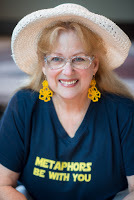 Ane Mulligan has been a voracious reader ever since her mom instilled within her a love of reading at age three, escaping into worlds otherwise unknown. But when Ane saw Mary Martin in PETER PAN, she was struck with a fever from which she never recovered—stage fever. She submerged herself in drama through high school and college. Years later, her two loves collided, and a bestselling, award-winning novelist emerged. She resides in Sugar Hill, GA, with her artist husband and a rascally Rottweiler. Find Ane on her website, Amazon Author page, Facebook, Twitter, and The Write Conversation.
Ane Mulligan has been a voracious reader ever since her mom instilled within her a love of reading at age three, escaping into worlds otherwise unknown. But when Ane saw Mary Martin in PETER PAN, she was struck with a fever from which she never recovered—stage fever. She submerged herself in drama through high school and college. Years later, her two loves collided, and a bestselling, award-winning novelist emerged. She resides in Sugar Hill, GA, with her artist husband and a rascally Rottweiler. Find Ane on her website, Amazon Author page, Facebook, Twitter, and The Write Conversation.
Published on February 27, 2022 22:00
February 26, 2022
If You Can Dream It, You Can Write It

by Craig von Buseck @ChurchWatch
“If you can dream it, you can do it.” – Walt Disney
Everything that exists was once an idea. In more romantic, Disneyesque terms, everything that is, once was a dream. The idea or the dream is the starting point for building the thing.
This concept is just as true—and perhaps even truer for the writer.
ImagineersIn the building of Disneyland and Disney World, Walt believed so strongly in the concept of “dreaming” in the creative process that he melded the worlds of the left-brained mechanical engineers with the right-brained creatives on his staff. By doing this, he set a new standard for amusement park design and building. He coined the term “imagineers” to describe these creative mechanics.
By bridging these worlds he freed analytical mathematicians to invent the animatronics for the inspiring Hall of Presidents, among dozens of other ground-breaking rides at the Disney parks.
Dreaming God’s DreamsWe know that dreams can be both part of the conscious world of making plans for the future, but also remarkable stories that play in our head when we sleep. I’ve always been a dreamer in both ways. The fact that our minds create worlds and scenarios in our subconscious minds should be an encouragement to any writer that your conscious mind is capable of truly remarkable creativity as well!
The Old Testament uses the Hebrew word ḥalom, referring to either an ordinary dream or one that is given by God. The New Testament use two different Greek words referring to dreams – the word onar, referring to message or oracle dreams, and enypnion, which can refer to both oracle and non-oracle dreams. The Bible also speaks of “night visions” or “visions in the night” referring to message or oracle dreams.
God gives us both types of dreams as a gift both of restorative sleep and as another means to communicate with us. The fact that you dream should build your confidence of the creativity available to you within your brain.
Once again, if you can dream it, you can write it.
Let Yourself DreamWhen I teach writing techniques I explain that the key to effective writing is:PrewritingWritingRewritingRewriting again (and sometimes again and again).One of the vitally important parts of prewriting is giving yourself time and room to dream of what your book or article could be. The dreaming process then leads to outlining and plotting.
I am convinced that the dreaming process in large measure separates good from great writers. Good writers go through the mechanics of outlining, plotting, and scene preparation. Great writers do all of those things, but FIRST they unleash their imaginations to dream of what their book could be – and then they take notes to capture those thoughts.
Dreams in Lincoln’s Top HatAmong American presidents, there are a few truly great writers/communicators, including John F. Kennedy and Ulysses S. Grant. Most historians and literary experts agree, however, that the greatest writer to ever occupy the White House was Abraham Lincoln.
Despite his very busy schedule as president, Lincoln purposely sought times of solitude to think, to meditate, and to dream. In these times, as important and moving ideas and words came to him, he captured them in a series notes. As creative and compelling thoughts came to him, Lincoln would pull out a pencil and a small pad of paper from his coat and jot down notes. Then he would tear out these small scraps of paper, fold them and place them inside the inner brim of his top hat.
Lincoln would ruminate on these ideas, especially as he was preparing a major speech. There would come a tipping point for the president when these individual ideas began forming into a full expression. At that point he would take out the various slips of paper and start the process of sewing them together into a full speech or text. This is how the Gettysburg Address, among other great Lincoln compositions were crafted.
Dreaming Breaks You Free from Writers BlockThose who struggle with writers block would do well to remind themselves that they can and do dream. If that is you, I encourage you to do this exercise of dream acknowledgement:During a one week period, place a notebook next to your bed to record every dream that can be remembered first thing in the morning. Write out as many details as you can recall.If in the course of a day you remember other details be sure to write them down as soon as possible. You can also record a voice memo with your phone to capture the thoughts.At the end of that week, review all your notes and allow your mind to spend some time thinking about and remembering the dreams from that week. In the midst of this review you may remember some dreams from the week that you haven’t captured. Write these new memories down as well.On the first day of the new week, using the same notebook, write down 5 to 10 of the most important and/or memorable dreams you can remember from your life.What is the purpose of this exercise? On the one hand it is a reminder to your conscious mind of the amazing creative capabilities of your subconscious brain. On the other hand, it is a priming of the pump for the release of your creativity. Feeding your mind with its own creativity helps to transfer that power from the subconscious to the conscious.
Linda Ronstadt tells the story of a recording session she participated in with the great songwriter Brian Wilson of the Beach Boys. In the midst of the session the musicians ran into a part of the song that was not working. Not one of these professional session musicians could figure out the problem so they decided to take a break. Everyone left the studio except Brian who remained at the piano. Instead of playing the song, he started playing a boogie-woogie piano riff.
Ronstadt sat in the recording booth and watched Wilson pound out this different tune for several minutes. Suddenly Brian stopped, looked over into the booth and announced, “I figured it out.” He had solved the problem that the other musicians were not able to untangle by freeing his mind to creatively flow through that boogie-woogie riff. The musicians all returned to the studio, amazed at the solution shared by the great Brian Wilson.
It is the same for all artists. While mastering the craft, grammar, and structure of writing, we must never forget the joy of dreaming and the ecstasy of creative expression. Each of us needs to allow ourselves to dream. For me, dreaming is often unleashed by hikes in the woods or in the mountains; by watching an inspiring movie, listening to a brilliant concert or song, or entering into musical worship. You need to find out what works to unleash your ability to dream.
As an artist, do what you must do to free yourself to dream creative dreams and then to write your best work!
TWEETABLEIf You Can Dream It, You Can Write It, encouragement & insight from Craig von Buseck (@ChurchWatch) on @EdieMelson (Click to Tweet)
 Dr. Craig von Buseck is an award-winning author and the Digital Content Manager for the Parenting section of FocusontheFamily.com. His most recent book is Victor! The Final Battle of Ulysses S. Grant. Learn more at vonbuseck.com.
Dr. Craig von Buseck is an award-winning author and the Digital Content Manager for the Parenting section of FocusontheFamily.com. His most recent book is Victor! The Final Battle of Ulysses S. Grant. Learn more at vonbuseck.com.
Published on February 26, 2022 22:00
February 25, 2022
Five Clever Techniques for Writers to Make Your Audience Care

by Zena Dell Lowe @ZenaDellLowe
One of the most important skills you can learn as a writer is how to draw your readers into your story and keep them invested all the way to the end. You start by creating a character that is either likeable, sympathetic, or intriguing. But how do you sustain the emotional bond you’ve established between your main character and the audience? How do you make your readers care about your main character’s journey for the rest of the story?
Master Techniques to Make Your Readers Care
1. Make sure they're good at something. We're attracted to people who are good at something. Could be their jobs, a skill, a talent, some kind of ability that they possess that others around them don't. In The Talented Mr. Ripley, his skill is his uncanny ability to take on the characteristics of whatever kind of person he needs to be. The name of the film even testifies to this: The Talented Mr. Ripley. In As Good as It Gets,
Mr. Udall is a wealthy, accomplished novelist. We like that about him. We like him all the better knowing the hardships he must have overcome to attain that level of success.
Think of Napoleon Dynamite: “Everybody's got skills.” What made Napoleon so special was his surprisingly impressive moves. That dance sequence at the end was worth its weight in gold. As long as your character is good at something, even if he starts out a dork or a jerk, we will still be attracted to him in some way, because people who are good at something are compelling.
2. Give us a glimpse into their vulnerability. We need to understand that they have pain. No matter how confident they appear, no matter how everyone else in the story views them, the audience loves it when we get to see a glimpse of something that others in the story don't see, especially pain. The key is to pull back the curtain just enough to show us some kind of woundedness beneath the surface.
The great equalizer and common denominator of mankind is suffering, so when we see the pain in that person, we can relate, which automatically triggers our empathy. It makes us care. So, show us that there's something your character is hurting over, some wound from the past, some sort of healing that they need or want that they themselves may or may not be aware of, but that the readers can see. This will help forge a bond with the audience and keep us emotionally invested in their story.
3. Show us that there is more to the character than meets the eye. This is different than just showing us a vulnerability. I'm talking about showing us that they are not at heart what they seem to be at face. We need to see complexity, that there is more to them than we originally may have thought. It’s easy to dismiss or write off simplistic or one-dimensional characters. It’s much more difficult to dismiss someone who has multiple layers to their personality, regardless of if those layers are good or bad.
The villain who nevertheless rescues the homeless dog; the hero who’s too shy to talk to the girl; the mother who takes care of her family with perfection but then slips into the closet to cry.… These are characters we think we know in an instant, but who become immediately more compelling when you reveal something about them that we couldn’t have otherwise surmised. Contrast, complexity, paradox, and depth—the audience likes to be surprised. Naturally, you have to do the hard work of setting it up so that we're delighted, rather than baffled or confused, by what you’ve revealed. But supposing you've done that, you can bet that the audience just became more deeply invested.
4. Make sure they care about something that matters. We care about people who care about something. And I'm not talking about puppies or children with cancer, because those are a given. I'm talking about your character being personally invested in something that tugs at their own heartstrings. Maybe it's a cause, or an object of some kind, like a beautiful building or a piece of art at the museum. Maybe it’s another person, like a parent, a sibling, a friend in need. Maybe it's even somebody that everybody else in the world sees as a nuisance, like a belligerent, alcoholic next-door neighbor.
It doesn't matter, really, as long as it matters to your character. Having a character who cares about something or someone other than themselves shows the audience that your character is worth caring about. It could be anything, as long as it's a single entity. It can't be something like, “all the whales,” because it needs to be personal and not generic. But provided you do that, you will have a really good chance of making us care about your character.
5. Give them a good sense of humor. We love somebody that is able to laugh in the face of hardship—or better yet, make US laugh. Even if your genre isn’t comedy or the joke isn’t laugh-out-loud funny, a character with a sense of humor in a world full of suffering gives us hope on a subconscious level.
John Cleese wrote, “Laughter connects you with people. It's almost impossible to maintain any kind of distance when you're howling with laughter.” And if you’re worried about the possibility of the humor taking away from the “importance” of your story, don’t. Because humor is not the opposite of seriousness. It's the opposite of despair. Using it can give the important stuff even more weight. As Mark Twain said, “The human race has only one really effective weapon, and that is laughter.”
Who could forget Tommy Lee Jones’s portrayal of US Marshal Sam Gerard in The Fugitive? His deadpan humor literally made that film. We loved him AND we took him seriously. Or remember the battle sequences in Braveheart when the characters would be hunkered down and waiting to charge? We'd be on the edge of our seats. Then one of them would crack a joke and our hearts would burst wide open. The fact that they could employ humor in the face of such horrendous circumstances made us love them all the more. Joss Whedon once said, “Make it dark, make it grim, make it tough, but then, for the love of God, tell a joke.” Adding humor is often the key to making the audience connect with a character.
ConclusionAs storytellers, it’s essential that our audiences stay emotionally invested in our characters’ journeys. While there may be many possible ways to accomplish this, these five techniques are among the best. Master these, and you will be well on your way to creating and sustaining a solid emotional bond between your readers and your main character.
TWEETABLEFive Clever Techniques for Writers to Make Your Audience Care, insight from @ZenaDellLowe on @EdieMelson (Click to Tweet)
 Zena has worked professionally in the entertainment industry for over 20 years as a writer, producer, director, actress, and story consultant. Zena also teaches advanced classes on writing all over the country. As a writer, Zena has won numerous awards for her work. She also has several feature film projects in development through her independent production company, Mission Ranch Films. In addition to her work as a filmmaker, Zena launched The Storyteller’s Mission with Zena Dell Lowe, a podcast designed to serve the whole artist, not just focus on craft. In 2021, Zena launched The Storyteller’s Mission Online Platform, where she offers advanced classes and other key services to writers. Zena loves story and loves to support storytellers. Her passion is to equip artists of all levels to achieve excellence at their craft, so that they will truly have everything they need to change the world for the better through story.
Zena has worked professionally in the entertainment industry for over 20 years as a writer, producer, director, actress, and story consultant. Zena also teaches advanced classes on writing all over the country. As a writer, Zena has won numerous awards for her work. She also has several feature film projects in development through her independent production company, Mission Ranch Films. In addition to her work as a filmmaker, Zena launched The Storyteller’s Mission with Zena Dell Lowe, a podcast designed to serve the whole artist, not just focus on craft. In 2021, Zena launched The Storyteller’s Mission Online Platform, where she offers advanced classes and other key services to writers. Zena loves story and loves to support storytellers. Her passion is to equip artists of all levels to achieve excellence at their craft, so that they will truly have everything they need to change the world for the better through story.To find out more about Zena or her current courses and projects, check out her websites at WWW.MISSIONRANCHFILMS.COM and WWW.THESTORYTELLERSMISSION.COM
Featured Image: Photo by Alexandra Fuller on Unsplash
Published on February 25, 2022 22:00
February 24, 2022
How to Banish Writing Fears: The Cure for What If Disease

by Lori Hatcher @LoriHatcher2
I’ve recently had the thrill of celebrating with several author friends. After years of working hard, improving their craft, networking, and building their platform, they’ve finally received a coveted book contract. Without exception, as soon as the confetti settled, each has been seized by a fearful case of What If .
What if I can’t make my deadline? What if I run out of ideas before I finish the book? What if I’m not ________ (fill in the blank—organized, smart, creative, inspired) enough to pull this off? What if my platform isn’t big enough to sell books?
I know the What If disease well because I’ve succumbed to it almost every time I’ve signed my name to a contract.
Only recently have I found a way to fight back.
Exodus 31 holds the key.
God had given detailed blueprints for the tabernacle and its furnishings. He described the elaborate curtains, the ark of the covenant, the table of showbread, the golden lampstand, and the exquisite priestly garments. He had a plan for every aspect of the structure, and He entrusted his plan to his faithful servant, Moses.
I wonder how Moses felt as he considered the enormity and complexity of the project. Would he succumb to the What Ifdisease?
Perhaps this is why God inserted the words of chapter 31:1-6 into the storyline:
Then the Lord said to Moses, “See, I have chosen Bezalel son of Uri, the son of Hur, of the tribe of Judah, and I have filled him with the Spirit of God, with wisdom, with understanding, with knowledge and with all kinds of skills— to make artistic designs for work in gold, silver and bronze, to cut and set stones, to work in wood, and to engage in all kinds of crafts. Moreover, I have appointed Oholiab son of Ahisamak, of the tribe of Dan, to help him. Also I have given ability to all the skilled workers to make everything I have commanded you.
Do you see the cure?
“I have given ability to all the skilled workers to make everything I have commanded you.”
Whether we live in Canaan or Cincinnati, God has a plan to glorify Himself. He’s creating a kingdom that will stand as a testimony to the world and draw people to salvation. In every generation, He reveals His plan to His people. Then He equips and prepares them (us) to join Him in the work. As we walk in the calling He places on our lives, we experience the joy of sharing in what He is doing.
While we have a responsibility to work hard, we can do so with confidence. If God has called us to be part of His work, He’s also given us everything we need to succeed—for our good and His glory.
What if we walk in this truth the next time an opportunity comes our way?
TWEETABLEHow to Banish Writing Fears: The Cure for What If Disease from @LoriHatcher2 on @EdieMelson (Click to Tweet)
 Lori Hatcher is an author, blogger, writing instructor, women’s ministry speaker, and career dental hygienist. She writes for Our Daily Bread, Guideposts, Revive Our Hearts, and Crosswalk.com. Lori’s latest devotional, Refresh Your Prayers, Uncommon Devotions to Restore Power and Praise, releases March 1 with Our Daily Bread Publishing. Connect with her at www.LoriHatcher.com or on Facebook, Twitter (@lorihatcher2) or Pinterest (Hungry for God).
Lori Hatcher is an author, blogger, writing instructor, women’s ministry speaker, and career dental hygienist. She writes for Our Daily Bread, Guideposts, Revive Our Hearts, and Crosswalk.com. Lori’s latest devotional, Refresh Your Prayers, Uncommon Devotions to Restore Power and Praise, releases March 1 with Our Daily Bread Publishing. Connect with her at www.LoriHatcher.com or on Facebook, Twitter (@lorihatcher2) or Pinterest (Hungry for God).Featured Image: Photo by Kelly Sikkema on Unsplash
Published on February 24, 2022 22:00
February 23, 2022
Common Writing Obstacles (Part 2): Talent vs Learning
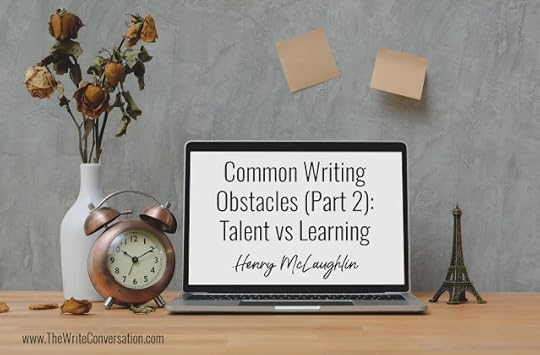
by Henry McLaughlin @RiverBendSagas
“You’re not a writer. You’re not even published.”
My superior at my day job spoke these words many years ago. They were his response when my immediate lead told him I was writing.
Talent has been described as something you either have or you don’t. You can’t learn it.
I and many others disagree with this notion. You can learn to be a writer whether or not you have talent.
The Difference Between Writing Talent and LearningThere are many gifted writers who seem to have been born with a natural talent for writing. I think of columnist George F Will and William Buckley, the founder of National Review. Writers like Hemingway, Asimov, Bradbury, Elmer Kelton, Dorothy Sayers, and others seem to write at a level we mere mortals can only think about approaching.
Yet, there are many authors who compose excellent stories that touch our hearts. Harper Lee’s To Kill a Mockingbird for one. Mark Twain is another. I’m sure we can all name writers who are superb to us. The funny thing is, they excite some readers and leave other readers cold.
Many, many factors go into being a brilliant writer. One frequently overlooked is it is quite possible to learn how to write significant stories. People learn how to be actors. They can learn to be writers too.
One key to learning to write is believing it’s possible. Another is to accept learning to write as a lifelong process.
We’ll refine our voice and our style with each project. We’ll learn about ourselves and how each of us can get better.
Take two people and give them a one sentence prompt. You’ll have two different stories. Each will have unique characteristics influenced by the individual writer’s life story, history of reading and writing, and their view of the world, and how the pizza they had for breakfast is settling in their stomach.
We’ve heard the cliché—to be a writer, you must be a reader.
It’s a cliché because it’s true. If we’re not reading what others write, we’re not learning. It’s important to read outside our genre to discover how other genres create story worlds, build plots, and develop characters. We need to be voracious readers.
We must also be students of what we read.
If I’m struggling with my story world, I’ll read or reread favorite authors who excel in this area—writers like Orson Scott Card, Morgan Llywelyn, Elmer Kelton, and Jacqueline Winspear.
For dialog, I’ll turn to Robert B. Parker, Terry Pratchett, and Steven James and others.
Besides reading, we need to get to a place where we can learn with and from others. Seminars, workshops, small groups, and conferences are all places to gather and learn. Working with a mentor or coach one-on-one is another way many writers develop confidence in their abilities.
Conferences will sometimes have special tracks that will meet daily over the course of the conference—a great way to dig deep into a topic while being with a community of other eager learners.
And there are books on the craft. There are a lot of books on the craft. Those that have helped me the most are Plot and Structure by James Scott Bell, Story Trumps Structure by Steven James, and Orson Scott Card’s Character and Viewpointand How to Write Science Fiction & Fantasy (1990). Don’t let the last the title fool you. Many of the principles Card describes to Sci-Fi are also helpful in other genres as well.
What are some ways you have developed your talent?
TWEETABLECommon Writing Obstacles (Part 2): Talent vs Learning, from Henry McLaughlin, @RiverBendSagas, on @EdieMelson (Click to Tweet)
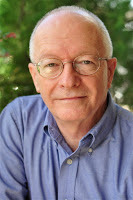 Henry’s debut novel, Journey to Riverbend, won the 2009 Operation First Novel contest.
Henry’s debut novel, Journey to Riverbend, won the 2009 Operation First Novel contest.Henry edits novels, leads critique groups, and teaches at conferences and workshops. He enjoys mentoring and coaching individual writers.
Connect with Henry on his BLOG, TWITTER and FACEBOOK.
Published on February 23, 2022 22:00
February 22, 2022
How Cooking Makes Me a Better Writer
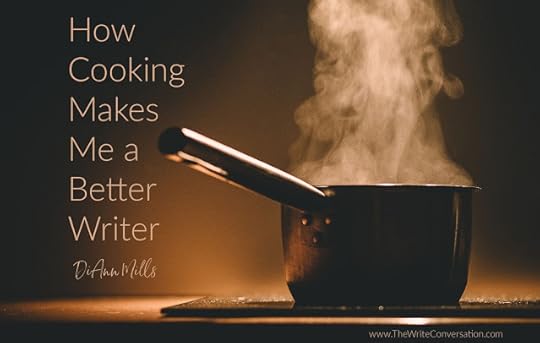
by DiAnn Mills @DiAnnMills
I like to cook and bake almost as much as I love writing. Spending time in the kitchen is relaxing, satisfying, and hopefully the results are tasty. I’ve discovered my passion for writing has a lot in common with food prep. Cooking makes me a better writer.
Look at the following comparisons, and I think you’ll understand what I mean.
Decide on a recipeWhen the mood strikes, I must decide what to cook. Similarly, I must choose a storyline. Contemporary romantic suspense is my preferred genre, and my writing recipe also needs an intriguing story line.
The right ingredientsFor a taste treat to win over others, decisions are in order. Who are my characters? What is their problem? Where is my story set?
Measure preciselyStory needs a balance of action and narrative woven with character emotions. In turn those emotions transfer to a reader’s experience. Growth and change happen when the character’s method of handling stress leads to critical errors and new measures of problem-solving flow fresh. How many mistakes will my character face? Can the reader see measurable growth?
Cut and diceEditing is the part of story writing where scenes are cut and diced. Making a story stronger means weak plot points must be slashed. The use of strong verbs and powerful nouns establishes a meatier story than sliding in adjectives and adverbs. Is the dialogue in character? Is the setting antagonistic so the character is forced to struggle? Where can a sentence be condensed to a phrase or a phrase to a single word?
Don’t be afraid to vary a recipeStory is king. Nothing reigns over story. While a writer follows rules and guidelines taught by professionals in the industry, sometimes those very same principles need to be tweaked. Try something new. Does it work?
Stir thoroughlyQuality writing means to shake up my characters. Force them to step into the unknown and forbidden. Throw in an ingredient midway that forever changes the story. Get your characters dirty. Make them smile, cry, angry, sad, and lonely. Always create the unpredictable.
BakeEvery story needs time to bake. When I walk away from my computer and refuse to open the file (oven door) for a specific time, the result is a fresh concept, and I can tell if it’s finished or needs a little more time.
Serve A writer never knows how readers will respond to a story. I can only work diligently and hope the book will be delicious, satisfying, and leave the reader wanting for more.
Are you ready to cook up a story?
TWEETABLEHow Cooking Makes Me a Better Writer, insight from @DiAnnMills on @EdieMelson (Click to Tweet)
 DiAnn Mills is a bestselling author who believes her readers should expect an adventure. She creates action-packed, suspense-filled novels to thrill readers. Her titles have appeared on the CBA and ECPA bestseller lists; won two Christy Awards; and been finalists for the RITA, Daphne Du Maurier, Inspirational Readers’ Choice, and Carol award contests.
DiAnn Mills is a bestselling author who believes her readers should expect an adventure. She creates action-packed, suspense-filled novels to thrill readers. Her titles have appeared on the CBA and ECPA bestseller lists; won two Christy Awards; and been finalists for the RITA, Daphne Du Maurier, Inspirational Readers’ Choice, and Carol award contests. She is the former director of the Blue Ridge Mountain Christian Writers Conference, Mountainside Marketing Retreat, and Mountainside Novelist Retreat with social media specialist Edie Melson. Connect here: DiAnnMills.com
Published on February 22, 2022 22:00
February 21, 2022
One Struggle This Introverted Writer Faces
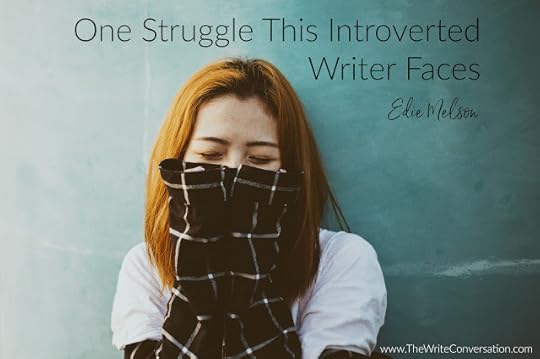
by Edie Melson @EdieMelson
They conquered him by the blood of the Lamb and by the word of their testimony, for they did not love their lives in the face of death (Revelation 12:11 HCSB).
Once again I found myself facing a video camera and being interviewed about being a writer.
“What do you find hardest about being a writer?”
Situations like this, was the answer on the tip of my tongue.
Fortunately I had prayed for God to put a guard over my tongue, and I managed to stammer out a less revealing answer.
I absolutely hate being interviewed with me as the focus.
You see, I’m a background sort of girl, and any kind of attention makes me desperately uncomfortable. And, in my mind, I’ve always thought that was the way it should be. I’m only where I am because of God’s blessings—not anything I’ve done. So situations that bring attention on me seem to diametrically opposed to bringing glory to God.
Then one day I was told differently.
Who dared to argue with my supposed biblical point of view? Someone whose authority I couldn’t fight—God.
It was the verse in Revelation 12:11 that is printed above that stopped me in my tracks.
There it was, one powerful word— testimony —that word caused me a death of sorts. The death of my quiet, comfortable, life-in-the-shadows life. You see, my testimony is what God has done in my life. And God wants to use my story to defeat the enemy.
Have you ever tried to share a personal testimony without talking about yourself? Don’t bother trying—trust me. It’s not possible.
So what am I going to do with this information? The only thing I can do—try to be obedient—no matter how uncomfortable it makes me. Because the one thing I know is that this life isn’t about me.
Below is a prayer for those of us who struggle with this dilemma
A Prayer for Boldness
He proclaimed the kingdom of God and taught about the Lord Jesus Christ—with all boldness and without hindrance! (Acts 28:31 NIV).
Dear Lord, You are a God of courage and boldness. You lead Your followers into victories that cannot be imagined. So why am I so timid and fearful when it comes to speaking about You?
At first, it seemed that my reticence stemmed from a desire to be humble, but now I’m not so sure my attitude is fully accurate. I know I would be nothing without You, but you’ve been so active in my life. So I’m struggling with how to share all those amazing moments without mentioning me.
I want everyone to know the powerful ways You’re working in my life. At the same time, I don’t want to call attention to myself. It’s a difficult tightrope to walk, and I need Your guidance.
Give me boldness without fear when I speak of You. Don’t let inaccurate comments from others lead me to be silent about You.
Show me how to share Your work and Your presence in my life without bragging about me. Keep me from any false humility that doesn’t honor You. Most of all don’t ever let me believe that any of my success stems from me. Amen.
*This post is an excerpt from Soul Care for Writers (Bold Vision Books 2019)
TWEETABLEOne Struggle This Introverted Writer Faces, insight from @EdieMelson (Click to Tweet)
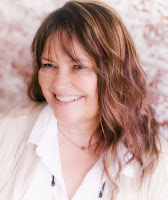 Edie Melson is a woman of faith with ink-stained fingers observing life through the lens of her camera. No matter whether she’s talking to writers, entrepreneurs, or readers, her first advice is always “Find your voice, live your story.” As an author, blogger, and speaker she’s encouraged and challenged audiences across the country and around the world. Her numerous books reflect her passion to help others develop the strength of their God-given gifts and apply them to their lives. Connect with her on her website, through Facebook, Twitter, and Instagram.
Edie Melson is a woman of faith with ink-stained fingers observing life through the lens of her camera. No matter whether she’s talking to writers, entrepreneurs, or readers, her first advice is always “Find your voice, live your story.” As an author, blogger, and speaker she’s encouraged and challenged audiences across the country and around the world. Her numerous books reflect her passion to help others develop the strength of their God-given gifts and apply them to their lives. Connect with her on her website, through Facebook, Twitter, and Instagram.Featured Image: Photo by Larm Rmah on Unsplash
Published on February 21, 2022 22:00
February 20, 2022
Things Authors Can Learn from Winning Marketing Campaigns

by Karen Whiting @KarenHWhiting
In November 2022 three authors won the Christian Author’s Marketing Excellence Awards. Let’s find out what they did that worked.
Motivation to Market
Ginny Brent Dent won the gold medal for her promotion of Unleash You God-Given Healing: Eight Steps to Prevent and Survive Cancer. Although this is the book she never wanted to write, she’s passionate about helping people prevent cancer or go through the journey easier. That motivates her to continually promote the book. Motivation keeps a writer focused and helps them persist, and wanting to help your readers is one of the best reasons to market the book. She built her campaign on her persistence to spread the news about the help her book offers. It’s projected that by 2030 100% of people will get cancer of some form.
Her title cover were key tools to grab attention and get medical validation. She needed support from the medical community to provide authority behind the book. Because Dr. Robert Elliott whose name is on some cancer patents came alongside her to write the forward and commentaries on sections of the book, that opened many doors for interviews and endorsements from others in the medical community. Her book helps people enhance their immune systems for more ammunition to prevent and fight cancer.
A great press release and her follow through led to interviews on 38 podcasts including ones in Australia and India, 8 TV appearances including CBN’s Healthy Living Show/700 Club and the Christian Television Network. She also secured 5 newspaper interviews and wrote articles for twenty magazines and 17 blogs. In total, the reach was 62.5 million people in 105 outlets. The book also won four awards.
Building the Audience
Annette O’Hare took the silver medal for her book Puppy Ciao. Annette who has written women’s fiction, switched to middle grade fiction, and focused on building a new audience. This is a long game for her as Puppy Ciao is the first book of a series. To establish herself in that genre she focused on reaching the parents. Her sites, although still modest, all grew exponentially. Her ROI was 10x the amount spent. She also created and used memes on Facebook and Twitter. The first two ads (one was a video ad) reached 7395 people.
The book won a bronze medal in the international Moonbeam Award helped increase the book’s reach as the contest included entries from 8 foreign countries. The contest sent press releases out to all the countries who participated.
It also helps to place the book into several categories on Amazon. Her second book reached the top 220 fairly soon after publication because she worked at connecting to her audience. Building an audience is always a priority, especially when moving into a new genre or for first time authors.
Drip Campaign and Marketing Audits
Jason Karpf won the bronze medal for his first fiction book Brimstone 1. Jason’s experience includes marketing and PR in the professional world (20 years) and ten years of teaching marketing at Christian Universities.
Currently he’s Donor relations director for Salvation Army, Northern Division). He brings his experience to book marketing, gearing up more as covid restrictions lessen. He concentrates on content and live presentations to small groups and churches. He works on growing his list of meeting planners and thus social media he prefers is linked in.
He designed a drip campaign of developing a relationship to garner speaking engagements with a goal of at least two speaking engagements monthly. He has been hitting his goal. A drip campaign is a plan to give the right people the information they need at the right time. Hopefully the targeted audience will then spread the word about the book.
One aspect of marketing that he teaches and applies himself is a marketing audit to expose the ineffective and obsolete methods to eliminate and pinpoint the effective methods. He reviews promotions done to see what has been effective and ineffective to eliminate what does not work and build mon what works. That creates smarter marketing and more effective use of time.
His book marketing focus has been content marketing with building information readers find valuable; and building relationships with meeting planners. He customizes talks for the audiences, such as one for a church that is mainly people who moved from Africa to a church where he spoke. His talk, “How long for the journey” explores the concept of space time and Jesus. One challenge in Sci-fi is to overcome space and time and God is the architect of the space time continuum.
Being focused and also doing a marketing audit leads to success over time. It helps an author find their marketing sweet spots. Whether a seasoned author, switching genres, or new, we can always learn from the efforts of other authors.
TWEETABLEThings Authors Can Learn from Winning Marketing Campaigns from @KarenHWhiting on @EdieMelson (Click to Tweet)
 Karen Whiting (WWW.KARENWHITING.COM) is an international speaker, former television host of Puppets on Parade, certified writing and marketing coach, and award-winning author of twenty-seven books for women, children, and families. Her newest book, The Gift of Bread: Recipes for the Heart and the Table reflects her passion for bread and growing up helping at her grandparent’s restaurant. Check out her newest book Growing a Mother’s Heart: Devotions of Faith, Hope, and Love from Mothers Past, Present, and Future. It's full of heartwarming and teary-eyed stories of moms.
Karen Whiting (WWW.KARENWHITING.COM) is an international speaker, former television host of Puppets on Parade, certified writing and marketing coach, and award-winning author of twenty-seven books for women, children, and families. Her newest book, The Gift of Bread: Recipes for the Heart and the Table reflects her passion for bread and growing up helping at her grandparent’s restaurant. Check out her newest book Growing a Mother’s Heart: Devotions of Faith, Hope, and Love from Mothers Past, Present, and Future. It's full of heartwarming and teary-eyed stories of moms.Karen has a heart to grow tomorrow’s wholesome families today. She has written more than eight hundred articles for more than sixty publications and loves to let creativity splash over the pages of what she writes. She writes for Crosswalk. Connect with Karen on Twitter @KarenHWhiting Pinterest KarenWhiting FB KarenHWhiting
Published on February 20, 2022 22:00
February 19, 2022
Persevere My Writer Friends
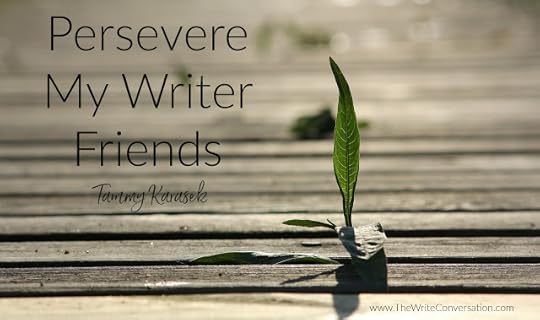
by Tammy Karasek @TickledPinkTam
I have spoken to writer friends since we turned our calendar page to 2022 about the ebb and flow of our writing lives. It’s no secret that we writers have word-filled days at our keyboards. But we never know when we’ll hit a day where we can’t string a coherent sentence together no matter how hard we try.
Could I be the only one barely chugging along? Once I fessed up my issue to my writing crew, I found I wasn’t. We all struggled to get the momentum going for this year.
One afternoon while praying for my writing friends, I was reminded of a serious situation this past fall in my writing and work. God had showed up and taught me I could actually take control of a writing problem and not let it be the boss of me. I’m not talking about issues out of my control, but those I do have control over … those I can find a work around option.
What God taught me in September is that I might not have everything in its perfect place, as my perfectionistic personality would like, but I’m quite capable of adapting and getting things done.
I’d gone to Colorado to work on my ninety-nine year old aunt’s estate. My first roadblock was the house where I’d be spending the next six weeks had no Internet. Gasp—I know, a house with no Internet. I did more than gasp. There may have been whining at this point.
I could have taken a break or written in a notebook. Except my writing wasn’t even the point I was most concerned about. I have two virtual assistant jobs and run a launch team business. I couldn’t leave the two virtual assistant jobs, two authors smack dab in the middle of their book launches or the other author I was helping with their launch on the back burner for such a long extended time.
If it wasn’t enough with no Internet and a full client load, my ten-year-old Mac Air had decided it didn’t want to do much. Limping along is an understatement. I didn’t have the time to shop for one in the middle of running all over Colorado Springs filing papers and seeing the attorney, accountant, selling her house and so much more.
I’d love to say at this point during my morning peace-filled, quiet time with the Lord, He showed me the way out of my dilemma. But I would be lying to you. The truth is that it was more like a small, sigh—okay, large—temper tantrum at the kitchen table. No peace. No quiet. But He met me there in that hot mess and showed me where to start on my dilemma.
I packed up my tote filled with work and laptop and off I went to the local Panera. My first day or two there it went well. I realized I needed to go early to get one of the few electric outlets they had. If my timing was off by even fifteen minutes, the outlets were taken. One of the outlets had lost the switch plate cover and hung out of the wall, which oddly was waist high in the seat of the booth.
I tried two other Panera spots that weren’t as close. They were larger and newer and I was excited. Bigger equals more outlets. Except the new or redesigned one have fewer outlets. When I asked the manager why no outlets, she laughed and said, “people come and work for hours and take up our tables for people who are actually buying food and eating.” She glanced at my bulging tote and I swear she laughed with the Cruella de Vil style cackle.
I didn’t panic, I knew God was teaching me a lot on this trip already. I worked until my battery teased me of closing down my computer. Then packed to leave and sent up a very articulate prayer. Well, God. Now what? Help would be great. I’m here for another month and I’m up to my neck in time-sensitive work. I got nothin’, Lord. I seriously contemplated sending off emails to my clients and confess my failure. But, I couldn’t formulate the words nor did I have any power left on my computer. Truth.
Six weeks later, I left for home. Great news, no work was left undone. I was able to find the outlets at my original Panera as needed. Even if it was usually the one hanging out of the wall. I’d learned how to get my charger out of the socket without getting shocked too bad. Exciting times.
We writers can often convince ourselves we can’t accomplish writing today because of something blocking us. But when obstacles get thrown in the way of our writing, we need to learn to take a breath, assess the situation and look for ways to step around or over them. Options are there, we need to be determined to go get them.
With that determination to find ways around the blocks and the perseverance to get those words on the page whether by keyboard or by longhand, you will find word count success, my dear writer friends.
Now, go and write.
TWEETABLEPersevere My Writer Friends, encouragement from @TickledPinkTam on @EdieMelson (click to tweet)
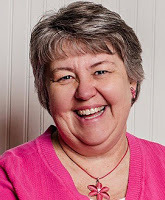 Tammy Karasek uses humor and wit to bring joy and hope to every aspect in life. Her past, filled with bullying and criticism from family, drives her passion to encourage and inspire others and give them The Reason to smile. She’s gone from down and defeated to living a “Tickled Pink” life as she believes there’s always a giggle wanting to come out!
Tammy Karasek uses humor and wit to bring joy and hope to every aspect in life. Her past, filled with bullying and criticism from family, drives her passion to encourage and inspire others and give them The Reason to smile. She’s gone from down and defeated to living a “Tickled Pink” life as she believes there’s always a giggle wanting to come out! She’s the Social Media Manager for the Blue Ridge Mountains Christian Writers Conference, Founding President and current Vice-President of ACFW Upstate SC, Founding President of Word Weavers Upstate SC. She’s a writing team member for The Write Conversation Blog, Novel Academy, and MBT Monday Devotions and others. Her work was published in a Divine Moments Compilation Book—Cool-inary Moments. When not writing Women’s Fiction and Rom-Com, she’s The Launch Team Geek helping authors launch their books and a Virtual Assistant for authors.
Connect with Tammy at HTTPS://WWW.TAMMYKARASEK.COM.
Published on February 19, 2022 22:00



